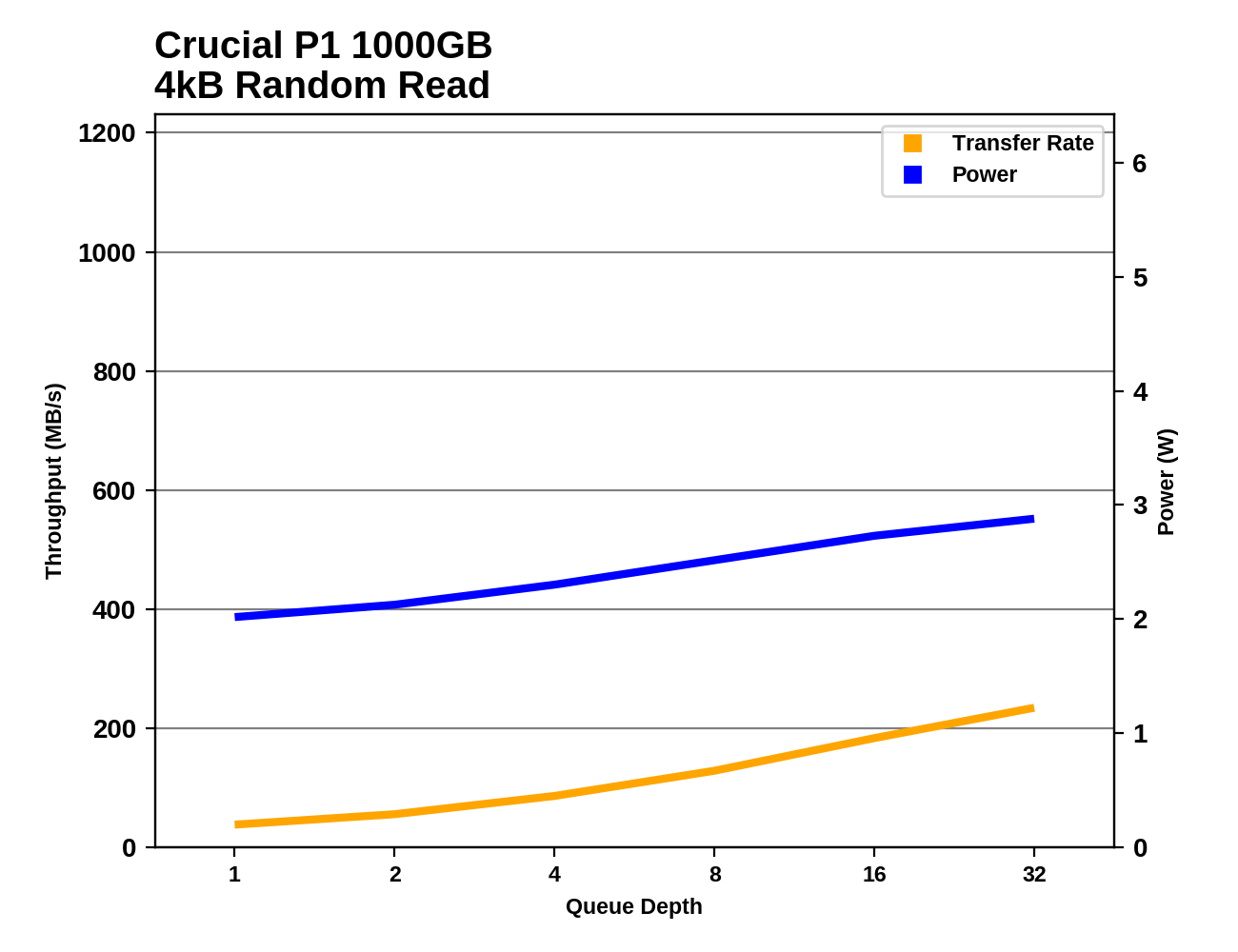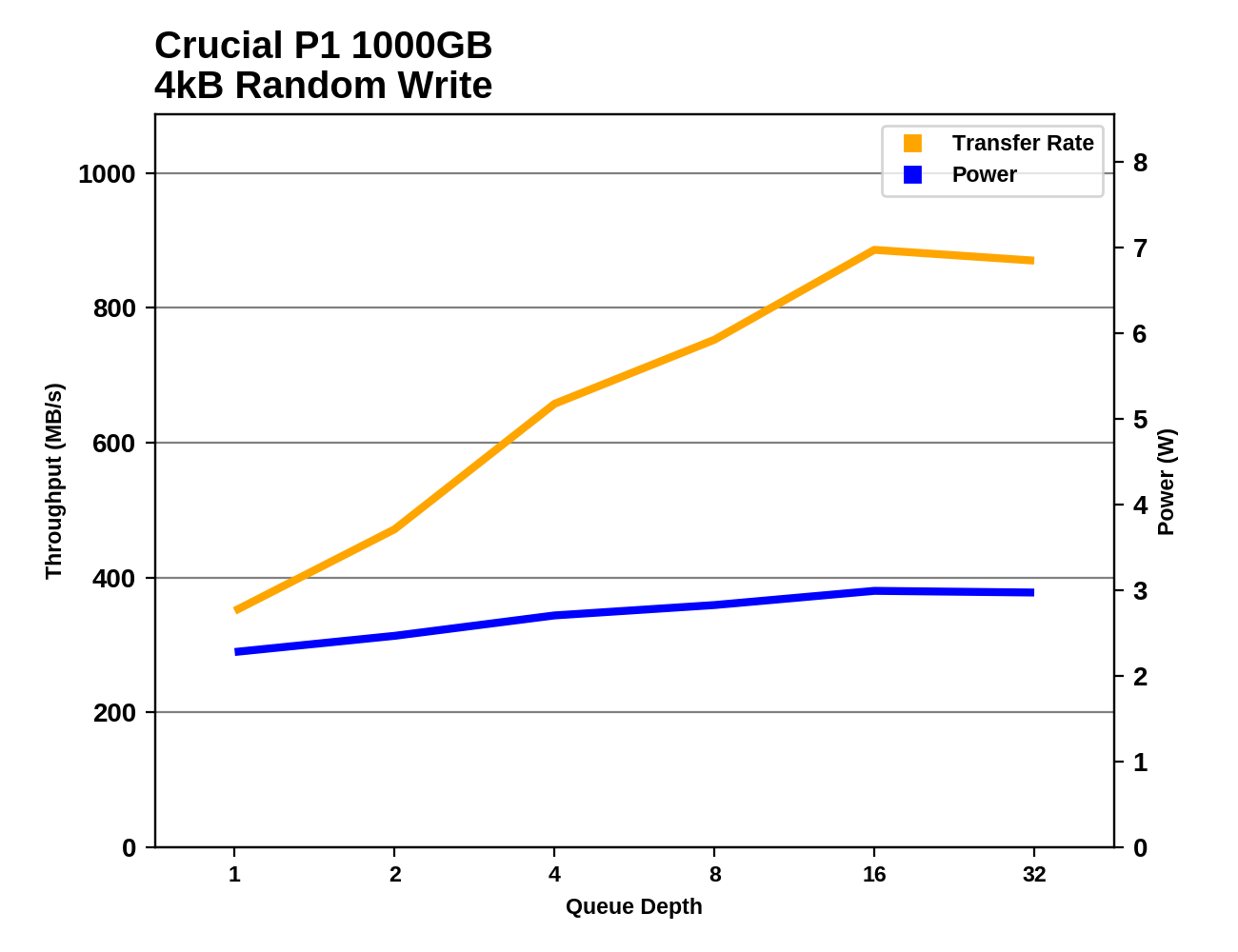The Crucial P1 1TB SSD Review: The Other Consumer QLC SSD
by Billy Tallis on November 8, 2018 9:00 AM ESTRandom Read Performance
Our first test of random read performance uses very short bursts of operations issued one at a time with no queuing. The drives are given enough idle time between bursts to yield an overall duty cycle of 20%, so thermal throttling is impossible. Each burst consists of a total of 32MB of 4kB random reads, from a 16GB span of the disk. The total data read is 1GB.

When the Crucial P1 has plenty of unused capacity and its SLC cache is large enough to contain the entire 16GB of test data, the burst random read performance is excellent. When the drive is full and the test data can no longer fit in the SLC cache, the performance falls behind the Crucial MX500 and most low-end NVMe SSDs.
Our sustained random read performance is similar to the random read test from our 2015 test suite: queue depths from 1 to 32 are tested, and the average performance and power efficiency across QD1, QD2 and QD4 are reported as the primary scores. Each queue depth is tested for one minute or 32GB of data transferred, whichever is shorter. After each queue depth is tested, the drive is given up to one minute to cool off so that the higher queue depths are unlikely to be affected by accumulated heat build-up. The individual read operations are again 4kB, and cover a 64GB span of the drive.

The sustained random read performance of the Crucial P1 at low queue depths is mediocre at best, falling behind most TLC-based NVMe SSDs and the Crucial MX500. By contrast, the Intel 660p manages to retain its high performance even on the sustained test, indicating that the Intel drive kept more of the test data in its SLC cache than the Crucial P1 does. When the test is run on a full drive, the P1 and the 660p have equivalent performance that is about 12% slower than the P1 with only the 64GB test data file.
 |
|||||||||
| Power Efficiency in MB/s/W | Average Power in W | ||||||||
The power efficiency of the Crucial P1 during the sustained random read test is less than half of what the Intel 660p offers, due almost entirely to the large performance difference. At just over 2W, the power consumption of the P1 is reasonable, but it doesn't provide the performance to match when the test data isn't in the SLC cache.
 |
|||||||||
The random read performance of the Crucial P1 increases modestly with higher queue depths, but it pales in comparison to what the Intel 660p delivers by serving most of the reads for this test out of its SLC cache. Even the Crucial MX500 develops a large lead over the P1 at the highest queue depths, while using less power.
Plotting the sustained random read performance and power consumption of the Crucial P1 against the rest of the drives that have run through our 2018 SSD test suite, it is clear that the drive doesn't measure up well against even most SATA SSDs, let alone NVMe drives that go beyond the SATA speed limit when given a sufficiently high queue depth. Thanks to its SLC cache being more suited to these test conditions, the Intel 660p is among those NVMe drives that beat the limits of SATA.
Random Write Performance
Our test of random write burst performance is structured similarly to the random read burst test, but each burst is only 4MB and the total test length is 128MB. The 4kB random write operations are distributed over a 16GB span of the drive, and the operations are issued one at a time with no queuing.

The burst random write performance of the Crucial P1 is good, but not quite on par with the top tier of NVMe SSDs. The Intel 660p is about 10% slower. Both drives clearly have enough free SLC cache to handle this test even when the drives are completely full.
As with the sustained random read test, our sustained 4kB random write test runs for up to one minute or 32GB per queue depth, covering a 64GB span of the drive and giving the drive up to 1 minute of idle time between queue depths to allow for write caches to be flushed and for the drive to cool down.

The longer sustained random write test involves enough data to show the effects of the variable SLC cache size on the Crucial P1: performance on a full drive is less than half of what the drive provides when it only contains the 64GB test data. As with the burst random write test, the P1 has a small but clear performance advantage over the Intel 660p.
 |
|||||||||
| Power Efficiency in MB/s/W | Average Power in W | ||||||||
When the sustained random write test is run on the Crucial P1 containing only the test data, it delivers excellent power efficiency. When the drive is full and the SLC cache is inadequate, power consumption increases slightly and efficiency is reduced by almost a factor of three.
 |
|||||||||
Even when the random write test is conducted on an otherwise empty Crucial P1, the SLC cache starts to fill up by the time the queue depth reaches 32. When the drive is full and the cache is at its minimum size, random write performance decreases with each phase of the test despite the increasing queue depth. By contrast, the Intel 660p shows signs of its SLC cache filling up after QD4 even when the drive is otherwise empty, but its full-drive performance is steadier.
Plotting the Crucial P1's sustained random write performance and power consumption against the rest of the drives that have completed our 2018 SSD test suite emphasizes the excellent combination of performance and power efficiency enabled by the very effective SLC write cache. The P1 requires more power than many SATA drives, but almost all NVMe drives require more power to deliver the same performance, and the very fastest drives aren't much faster than the peak write speed of the Crucial P1.












66 Comments
View All Comments
Billy Tallis - Thursday, November 8, 2018 - link
I think you were looking at the price for the 1TB 970 EVO. The 1TB 970 PRO is currently $392.99 on Amazon, closer to twice the price of the Crucial P1. I think it is occasionally reasonable to get something like the 970 EVO for a high-end system. Going past that to a 970 PRO isn't reasonable.PeachNCream - Thursday, November 8, 2018 - link
Whoops, you're correct! Please accept my apologies for that one.DigitalFreak - Friday, November 9, 2018 - link
Even then, the 970 EVO wipes the floor with the P1.Death666Angel - Thursday, November 8, 2018 - link
Who wants QLC NVME drives as the first widely available consumer QLC tech? Not me I tell you! :DI am fine with 3D TLC for my performance needs both from a performance and price point at the moment. 500GB is enough for many casual enthusiasts and 1TB isn't too expensive either. I'd really like 2.5" SATA and M.2 SATA QLC for my casual media storage needs.
Lolimaster - Friday, November 9, 2018 - link
QLC is such useless product except for manufactures, they give you a WORST product for basically the same price or more than a TLC.MX500/860 EVO 1TB for $160-180.
Lolimaster - Friday, November 9, 2018 - link
*Edit 155-160.piroroadkill - Friday, November 9, 2018 - link
QLC doesn't seem to make any sense in an M.2 PCIe NVMe format - it's just really slow compared to even a good SATA 6Gbps SSD. QLC seems to make sense in a 2.5" SATA format, with an enormous capacity. 1TB makes no sense for this shitty performance level. It needs to be there to replace larger drives. Actually, even that makes no sense for a home user - where long term retention is more important, and a hard disk is therefore more useful. QLC drives will probably come into their own at the ~4TB mark in Enterprise storage arrays as a mid-tier storage solution, with hard disks under, and MLC NAND above.crotach - Friday, November 9, 2018 - link
Oh dearThe_Assimilator - Friday, November 9, 2018 - link
Why the bloody bejesus do these manufacturers keep tying ever-slower NAND to ever-faster interfaces? If you want your bloody QLC NAND to be a success, Crucial, make a 2TB+ SATA SSD that costs less per gigabyte than any other SSD on the market, and watch them fly off the shelves. You already got this right with the Micron 1100 series that uses 3D TLC NAND, why can't you do it for QLC?The_Assimilator - Friday, November 9, 2018 - link
Ah, I see that Micron is touting their "5210 ION" series SSDs (using 3D QLC NAND) as "hard drive replacements", and they start at 2TB. Write speeds are not great, but I don't care and I doubt most consumers looking for high-capacity SSDs will either. Hopefully there will be stock of these in time for Black Friday!